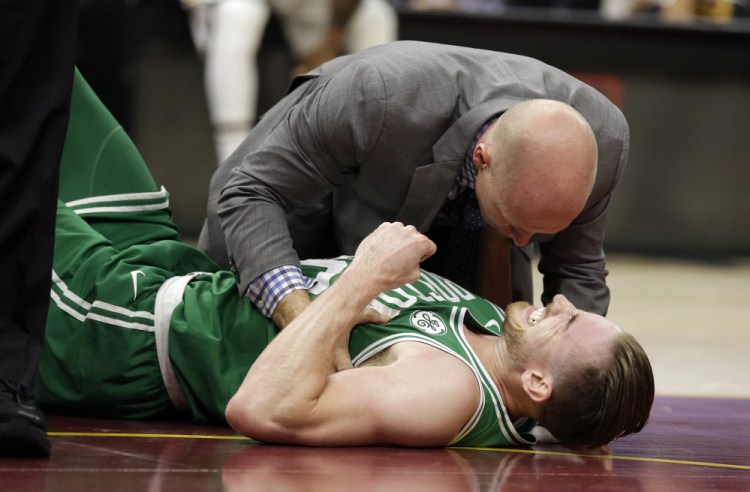CLEVELAND — Tuesday night’s game between the Cleveland Cavaliers and Boston Celtics was one of the most anticipated basketball nights of the year. It marked both the return of Kyrie Irving to face the team he asked to be traded away from earlier this summer and the beginning of the 2017-18 NBA season.
Less than halfway into the first quarter, none of that mattered anymore.
Gordon Hayward, the All-Star forward making his Celtics debut after signing as a free agent this summer, fell awkwardly after colliding with LeBron James while going for an alley-oop pass and crashed to the floor. His left foot pointed in the wrong direction after he dislocated his ankle and fractured his left tibia.
In an instant an arena that had been full of frenetic energy was shocked into a sudden silence, while players on both teams reacted in horror. And at the same time a team that entered the season projected to be among the NBA’s elite now finds itself staring at a far different reality from it was expecting.
Boston eventually fought back from an 18-point deficit to lose 102-99, but the result was largely irrelevant. Hayward’s injury – and the impact it had on both the Celtics and the rest of the Eastern Conference – pushed all other storylines to the rear.
It’s a reminder of how fragile roster-building can be. Teams spend months, if not years, preparing meticulously to go into the offseason looking for specific ways to improve and then do their best to execute those plans.
Boston did exactly that this summer, not only convincing Hayward to leave the Utah Jazz to rejoin Celtics Coach Brad Stevens – his college coach at Butler – but pulling off one of the most stunning trades in recent years to land Irving.
By pairing the two of them with Al Horford, the Celtics felt like they had a chance to give James his biggest challenge during his seven-plus years of Eastern Conference dominance, while at the same time setting themselves up to be a contender for years to come.
Now all of that has been thrown into the air. It’s still unclear when Hayward is going to be back, but anyone who witnessed the injury Tuesday night was under no illusions that such a recovery would be a speedy one. And frankly, speed isn’t the important thing here; it is ensuring that Hayward, who has developed into one of the league’s best and most complete forwards and an annual all-NBA candidate at one of the league’s deepest positions, is able to return to that level in the future.
“You hurt for him,” Stevens said. “He’s put in a lot of great work, and I thought he had his most comfortable week as far as feeling like he was going to play really well. Now hopefully we get a full recovery.
“It’s a tough deal but I guess that’s part of it, the risk of injury. I really feel for him.”
With Hayward sidelined at a minimum for months, it’s hard to see the Celtics as anything but a mid-tier playoff team in the Eastern Conference, at best.
Yes, they have plenty of young talent, including the past two No. 3 overall picks in Jaylen Brown and Jayson Tatum – both of whom showed flashes of their significant potential in the opener.
But Boston sacrificed quality depth to acquire Irving and Hayward, making Jae Crowder part of the package that went to Cleveland for Irving and shipping Avery Bradley to Detroit for Marcus Morris, allowing the Celtics to clear just enough salary-cap space to be able to sign Hayward.
Those were moves any team would – and should – do to land players of Irving and Hayward’s caliber. But they forced Boston to sacrifice a good portion of the depth that made it successful last season in exchange for being able to rely on truly top-end talent.
The problem is that with one of those top-end talents now gone, the burden has grown on the team’s inexperienced depth pieces to pick up the slack in Hayward’s absence.
Hayward’s injury also blows open the top of the Eastern Conference, where many had presumed the Celtics would be positioned alongside the Cavaliers this season. The team that now has to assume the pole position for a top-two seed alongside Cleveland is the Washington Wizards.
There already wasn’t much of a gap between the two teams even before Hayward’s injury. After it? One could argue the Wizards are the clear favorites to secure home court until at least the Eastern Conference finals – and, with it, yet another chance to end Washington’s 20-year drought without a conference final appearance in any of the four major professional sports.
But none of that was on the minds of anyone in Cleveland on Tuesday night. Instead, it was the image of Hayward on the ground, his left leg bent at the knee and his foot pointing in the wrong direction.
“It was very difficult,” Cavaliers Coach Tyronn Lue said. “Even though he was from the opposing team, we’re still a fraternity, and we’re still brothers. You never want to see anyone get injured or go down like that.”
Send questions/comments to the editors.


